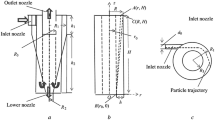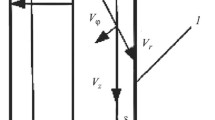The problem of modeling the process of separation of suspensions and emulsions in a centrifugal field under the condition of geometric and hydrodynamic similarity of the parameters of hydrocyclones installed in a battery is considered. An example of the calculation of the necessary number of hydrocyclones providing the required degree of purification is given.



Similar content being viewed by others
References
V. O. Yablonskii, “Influence of constructive parameters of a hydrocyclone on the hydrodynamics of a nonlinear viscoplastic fluid,” Khim. Neftegaz. Mazhinostr., No. 8, 6–10 (2015).
M. G. Lagutkin, S. Yu. Bulychev, and V. М. Pigarev, “Application of hydrocyclones with a receiving hopper for purification of circulating water to remove mechanical impurities,” Khim. Neftegaz. Mashinostr., No. 11, 3–5 (2004).
D. A. Baranov, A. I. Pronin, and V. A. Dikov, “Hydrocyclones for chemical manufactures and circulating and wastewater purification plants,” Khim. Neftegaz. Mashinostr., No. 7, 20–22 (2007).
A. I. Pronin, A. A. Ivanov, and N. A. Kudryavtsev, “Technological equipment for the production of hydrocyclones from plastics,” Khim. Neftegaz. Mashinostr., No. 1, 40–42 (1998).
A. M. Kutepov, D. A. Baranov, and M. G. Lagutkin, “Experience in the creation and application of hydrocyclones in chemical technology processes,” Khim. Neftegaz. Mashinostr., No. 1, 28–37 (2000).
A. S. Timonin, Engineering and Environmental Reference Book, Noosfera, Kaluga (2015), Vol. 2.
I. G. Ternovskii and A. M. Kutepov, Hydrocycloning, Nauka, Moscow (1994).
A. I. Povarov, Hydrocyclones in Concentrating Plants, Nedra, Moscow (1978).
K. F. Pavlov, P. G. Romankov, and A. A. Noskov, Examples and Tasks on the Course of Chemical Technology Processes and Devices, TID Al’yans, Moscow (2007).
A. B. Golovanchikov, M. I. Lamskova, and M. I. Filimonov, “Comparison of the probability of particle trapping in a pressure hydrocyclone in the case of a conventional and a two-layer flow,” Izv. VolgGTU, Ser. Reol., Prots. Appar. Khim. Tekhnol., Iss. 8, No. 1 (154), 64–67, Volgograd (2015).
A. B. Golovanchikov, M. I. Lamskova, and M. I. Filimonov, “Simulation of the processes of purification of oil sludge in the hydrocyclone to simultaneously remove the ‘heavy’ and ‘light’ particles of the dispersed phase,” Izv. VolgGTU, Ser. Akt. Probl. Upravl., Vych. Tekhn. Informat. Tekhn. Sist., No. 11 (190), 8–13, Volgograd (2016).
A. B. Golovanchikov and B. V. Simonov, The Use of Computers in Chemical Technology and Ecology. Part 2. Modeling Hydromechanical Processes: Textbook, Tsaritsyn, Volgograd (1995).
Author information
Authors and Affiliations
Corresponding author
Additional information
Translated from Khimicheskoe i Neftegazovoe Mashinostroenie, No. 2, pp. 34–38, February, 2018.
Rights and permissions
About this article
Cite this article
Golovanchikov, A.B., Novikov, A.E., Lamskova, M.I. et al. Modeling the Process of Separation of Non-Homogeneous Liquid Disperse Systems in a Hydrocyclone Accounting for Similarity Criteria. Chem Petrol Eng 54, 118–124 (2018). https://doi.org/10.1007/s10556-018-0449-4
Published:
Issue Date:
DOI: https://doi.org/10.1007/s10556-018-0449-4




